Florida – America’s Crystal Ball
South Florida Water Management District Uses Climate Change Models to Guide Planning

(Updated August 2021)
South Florida is America’s test well for tracking the impact of rising oceans and flashy storms. The region’s 8 million inhabitants live in cities and towns that are, in some cases, just inches above sea level, and the flat landscape is especially prone to flooding.
South Florida is at the end of a peninsula that is threatened by water on three sides, as well as from above and below. The skies inundate the region with more than 53 inches (134 cm) of rainfall per year, mostly between June and October. Hurricanes swirl through the Atlantic Ocean and Gulf of Mexico and crash into land. Fertilizers, agricultural chemicals, urban runoff and seawater wash over the fragile Everglades, the largest freshwater wetland in the U.S. And salt water quietly creeps into the leaky limestone bedrock to replace fresh water pumped out to supply an ever-growing population.
South Florida is—quite literally—getting into deep water as the climate changes.
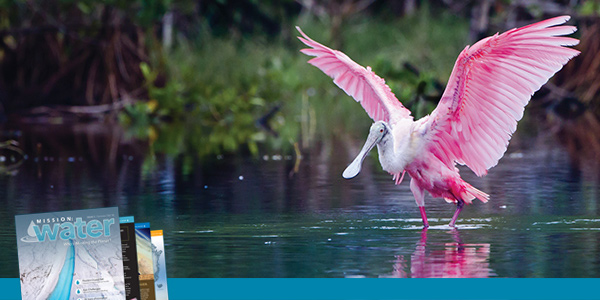
A Rosette Spoonbill in the Florida everglades.
As sea levels rise and storm surges push water ashore, the staff of the South Florida Water Management District (SFWMD) will be among the first to deal with it.
Serving 16 counties from Orlando down to the end of the Florida Keys, the district manages flood control and water delivery in conjunction with dozens of state, county and local governments and utilities.
>> Download full copy of Mission: Water Magazine
It also coordinates environmental restoration in the Everglades. Every step of the way, an in-house team of engineers and scientists guides the district's planning and operations.
Akintunde Owosina, chief of SFWMD's Hydrology and Hydraulics Bureau—who oversees the modeling unit—notes that using the district's technical capabilities to assist and coordinate with local governments and other stakeholders is just as important as using them to plan its own responses to sea level rise.
"We are not just one organization stepping up," he says. "It requires many to affect something that is robust to mitigate sea level rise. We operate as one part of a three-tiered flood control system, and the other parts are run by others. There has to be tight integration to be able to come up with effective adaptation strategies."
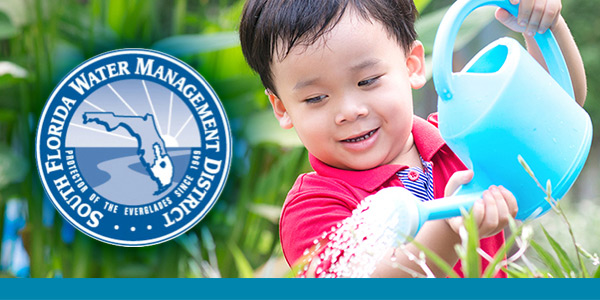
SFWMD manages the water resources in the southern half of the state, covering 16 counties from Orlando to the Florida Keys. It is the oldest and largest of the state's five water management districts.
South Florida Water Management District
Based in West Palm Beach, Florida, SFWMD is a publicly funded entity that manages water for more than 8 million residents in a 16-county area from Orlando to Key West—a region that includes several of the state’s largest cities as well as the largest freshwater marsh in the U.S., the Everglades.
Its wide remit ranges from flood control to water procurement, ecological protection, and water quality.
Three Tiers
The first tier of the system, Owosina explains, is a network of flood control canals built by the U.S. government in the 1940s and 1950s to drain marshland for agriculture and development, supply fresh water to South Florida's growing cities, and drain stormwater following the area's infamous storms. Those main, or primary, canals are fed by secondary canals operated by counties, cities, and special drainage districts, which in turn accept water from tertiary systems that homeowner associations use to drain their neighborhoods.
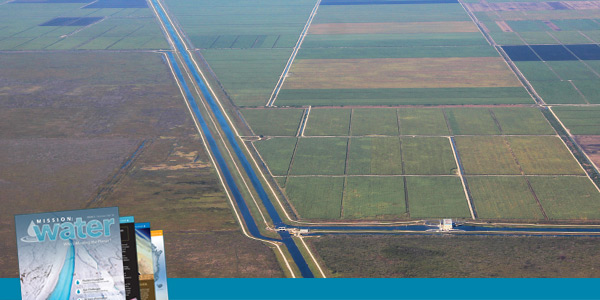
Farmlands south of Lake Okeechobee in the Everglades Agricultural Area. Everglades restoration focuses on restoring water flow through this area.
Over the years, more people and more pavement have increased pressure on all three layers of the drainage system.
And as high tides pushed saltwater inland through the canals, authorities added salinity barriers at the mouths of the waterways—gates that can be closed during high tides to prevent saltwater intrusion.
The district can close the barriers to ward off rising tides that could push salinity inland during storms, Owosina notes. He adds that as important as it is to manage the primary canal system, it is every bit as vital to also manage the water flowing into the primary canals from the feeder canals upstream.
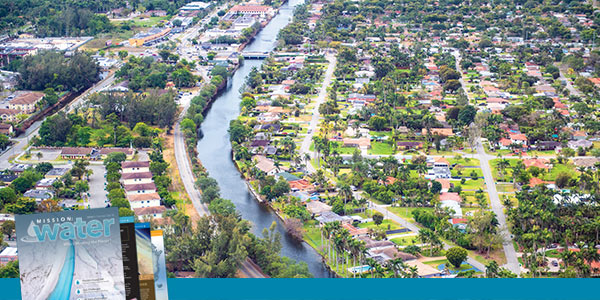
Tertiary canal systems allow for residential neighborhoods to drain their excess water.
As sea levels rise, it is important to predict how well those systems will perform in the future. Part of SFMWD's cooperation with stakeholders upstream is sharing the results of its Flood Protection Level of Service program, a deep assessment of the infrastructure that integrates information from current on-site inspections with detailed modeling of different future conditions, including sea level rise and weather scenarios.
"The program will cover around the entire district, starting with the highest priority watersheds, determine the current level of services, compare it to design conditions, and subject it to different future conditions [in the models] with future land use and changes in sea level," Owosina says. "Does this structure continue to provide the same level of flood protection it was designed to provide? We're hoping to see that it is robust, or that you can tell at what level of sea level rise it becomes less effective and provides less flood protection so that necessary action can be taken proactively."
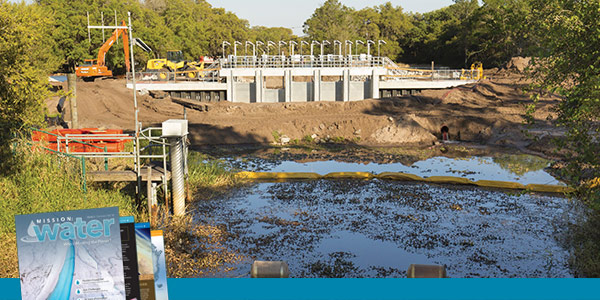
Water control facility under construction on the Zipper Canal in Lake Kissimmee State Park.
Turning the Question Around
For years, the modeling experts at the district have reviewed the science and math around climate change and sea level rise. They have reviewed the climate models to determine their applicability in Florida, and have reviewed the papers and technical publications that describe contributions to sea level rise from melting ice in Greenland and Antarctica, oscillations in ocean temperatures, sunspots, and flashier storms. They have collaborated with colleagues in the region to grapple with the uncertainty that plagues modeling projections of sea level and other effects of climate change—especially models that take into account massive numbers of variables—all with uncertainty.
Estimates of sea level rise range from half a meter (1.6 feet) to two meters (6.6 feet), which is not nearly specific enough to facilitate planning, Owosina notes.
"There is uncertainty in the science. There is uncertainty in the data. And there is uncertainty in the modeling tools themselves," he says. "There's a lot of uncertainty to go around.
"We backed away from making predictions," he notes. "Instead of using the models to predict sea level rise, we've turned the problem around to look at the infrastructure we're responsible for and determine what level of sea level will render the infrastructure ineffective.
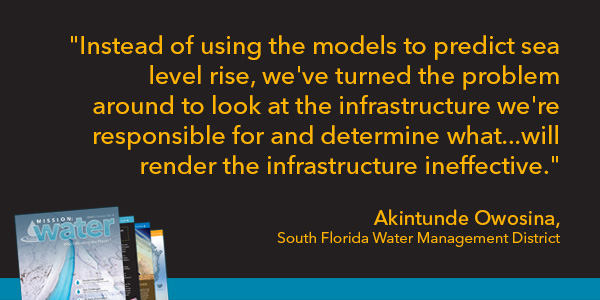
Quote from Akintunde Owosina, South Florida Water Management District.
"Then you can set aside the uncertainty and pick a trigger and say, 'when I get to this certain amount of rise, the system starts to operate ineffectively,'" Owosina explains. "If it takes 10 years to build new infrastructure, you set a threshold and say 'just before I hit that level, I'll begin building the new infrastructure.' If the estimates are wrong, you'll just get to the threshold faster, or later."
Modeling can help planners in the district or in associated municipalities understand the long-term benefits different adaptation strategies. For instance, Owosina says, a city could enlarge its canals or add pumps to increase floodwater discharge capacity, a fix that could contain flooding and prevent washed-out roads for five or 10 years. But raising the roads—while more expensive—could be a more efficient approach and a longer-term solution to keeping traffic on the move for decades to come.
"Things like that are what we can evaluate with models," he says. "We can compare costs and benefits of all cases, and look at what can be most effective in 15 to 20 years, 50 years, or the lifespan of some of the assets that can be 50 to 100 years."
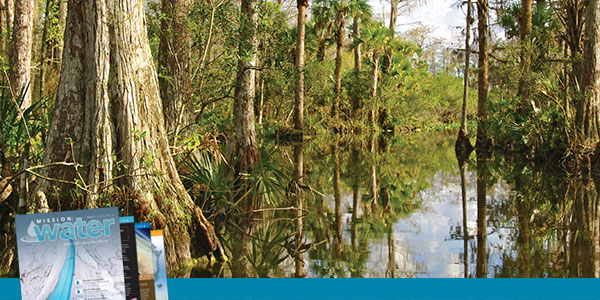
The Florida Everglades
Environmental Research
Modeling can also help forecast the role of the district's extensive, $14 billion restoration of the Everglades. Among a wide range of restoration projects, SFWMD is returning water to areas of the Everglades drained decades ago. That should help restore habitat and wetland function. It will also raise surface and ground water on the inland side of the canal system, increasing the region's ability to prevent saltwater intrusion.
>> Download full copy of Mission: Water Magazine
Every five years, beginning in 2009, SFWMD has also mapped the leading edge of saline water creeping into the aquifer under South Florida, marking its advances and retreats. Movement of the front could indicate a need for new well fields in some areas, Owosina notes.
"There is a balance that's struck between the location of the salt and fresh water, and it moves in and out a little bit," he says. "As sea level rises, the tendency is to push that front inland."
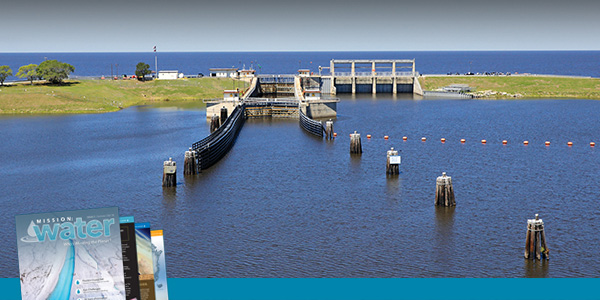
Lake Okeechobee and Port Mayaca Locks & Dam
Communication Remains Key
The district's modeling program starts with an evaluation of climate science, dives deep into planning, and resurfaces in a wide range of conversations with other local governments and districts. SFWMD works closely with counties and municipalities throughout South Florida, providing technical assistance and data.
The district also seeks inspiration and insight from colleagues around the world, Owosina notes.
"We work very closely with the Dutch," he says. "They have hundreds of years of experience working below sea level. And we work closely with local governments on grant funding and other projects."
SFWMD relies heavily on its modeling team and sound science to conduct analyses that inform and support decision-making.
"Modeling allows you to test something that you can't test in the real world," Owosina says. "You can evaluate what will happen in 50 or 60 years without waiting 50 or 60 years. You can experiment in dry-lab conditions, evaluating 'flooding' in an area without flooding anybody out. It allows you to make important decisions without incurring the actual costs of the issue."
That, he adds, delivers three key insights: "We need background information, we need to know the current state of the assets, and we need to plan for a resilient future."
Learn More:
South Florida Water Management District: www.sfwmd.gov
On Facebook: www.facebook.com/SFWMD
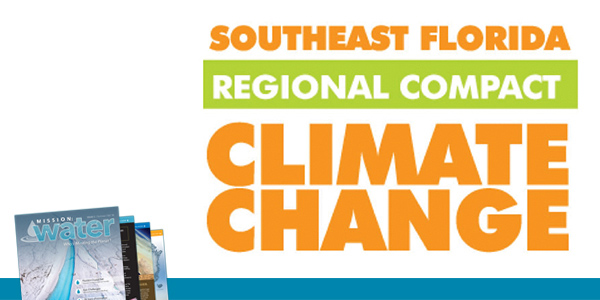
Southeast Florida Regional Climate Change Compact
At a 2009 conference on the impact of climate change on south Florida, leaders from four of the state’s southern counties—Broward, Miami-Dade, Monroe and Palm Beach—created the foundation for regional cooperation in adapting to changing conditions. The following year, the four counties signed the Southeast Florida Regional Climate Change Compact, a collaboration on several key climate efforts:
- Developing annual legislative programs on climate change, webinars, resource materials and an annual Regional Climate Summit
- Teaming up to advocate for state and federal policies and funding
- Drafting a Southeast Florida Regional Climate Action Plan outlining mitigation and adaptation strategies.
Over the next several years, the founding counties were joined by the governments of 35 municipalities in the region, whose leaders signed onto the Mayors’ Climate Action Pledge.
The SFWMD is not a signatory to the compact, notes Akintunde Owosina, chief of the district's Hydraulics and Hydrology Bureau, but it is deeply involved in helping the members achieve their goals.
The group is planning its 10th annual Summit to bring leaders from government, academia, business and the non-profit worlds together in Miami Beach in October 2018.

If you'd like to have your research or study published in one of our next issues of Mission: Water magazine, please send us an email and we'll discuss the possibility! Send email to missionwater@xyleminc.com and Brandon, Theresa, or Patrick will reach out ot you!
Steve Werblow is a freelance writer based in Ashland, Oregon who speiclaizes in agriculture, water, and industrial subjects. http://www.stevewerblow.com/